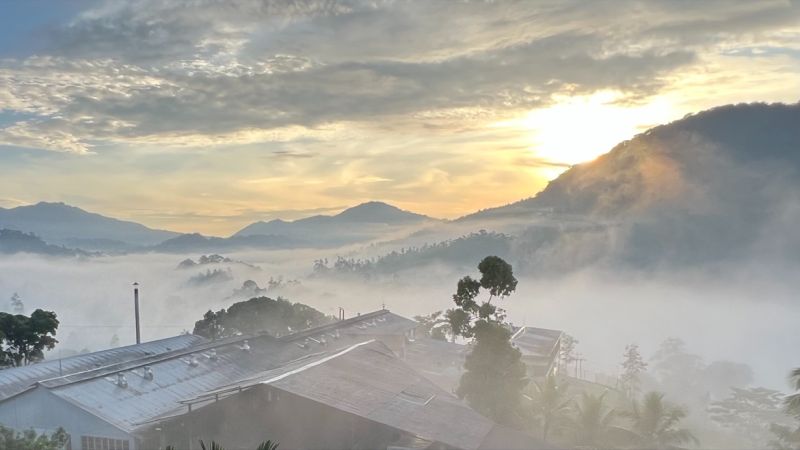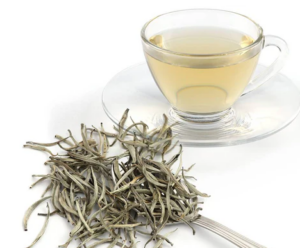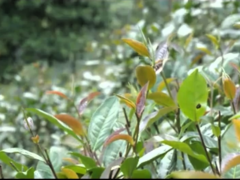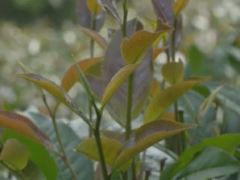
White tea is the least processed tea made from specific cultivars; in Sri Lanka, the most common cultivar is TRI 2043. This tea bush produces a reddish leaf and the all-important silver tea bud. Not every estate chooses this cultivar because it’s a very low-yielding plant. Those who use the cultivar typically make three styles of white tea: Golden Tips, Silver Tips, and a pure White Tea.
Most white teas in Sri Lanka are made from gardens at higher elevations. An exception is the Lumbini Tea Valley, located in the low country in the Ruhuna region at the island’s southern end. We are highlighting this tea here.
Ksenia Hleap, a spokesperson for the Agency for the Valorization of Agricultural Products (AVPA), writes, “Lumbini is a pioneer in organic farming in Sri Lanka and constitutes a real strength for the country. Through making exceptional teas, Lumbini Tea also participates in an ambitious project for human, ecological, and economic development in the region. This involves, in particular, the reforestation of certain parts of the plantation, the non-use of pesticides, the reduced use of fertilizing agents, and the natural renewal of the soil by avoiding plowing.”
Lumbini borders the Sinharaja rainforest, a UNESCO World Heritage Site. The terroir heavily influences the teas produced because of its proximity to the rainforest. The air is so pure that it significantly helps the development of the tea’s taste during oxidation. The pure air combined with the fertile soils and elevation produce exceptionally aromatic and flavourful teas. Lumbini is also the only tea estate in Sri Lanka with a plantation factory and an export arm situated within the same facility. This has enabled a retail arm to their tea production, allowing them to sell these small-batch white teas direct to consumers.
The decision to expand to white tea came from recognizing the need to offer tea lovers diverse styles, from classic black teas to the increasingly popular herbal blends.
The estate has dedicated approximately 10 acres to organically cultivating the 2043 purple clone exclusively for white tea production. Furthermore, they collaborate with small farmers, encouraging them to grow this unique cultivar organically. This has incentivized the local community to cultivate tea and benefit from it.
With the white tea range, the tea masters at Lumbini have set up to explore the full spectrum of flavours and aromas of the TRI 2043 clone. They show how various parts of the tea leaf can be harnessed to create a range of white tea styles, each offering a unique taste profile. Three leaf styles and two fruit blends are produced.
- Ceylon White Leafy: Made from two leaves and a bud, it carries a refreshing flavor and aroma of honeydew melon complemented by a hint of spicy floral musk.
- Pomegranate with Ceylon White Leafy: A blend of white tea (two leaves and a bud) with fruit flavours and rose petals.
- Guava and Peach with Ceylon White Leafy: A blend of white tea (two leaves and a bud) with tropical guava and delectable peach. Best Flavored White Tea: Golden Award, Golden Leaf Awards, Australia (2017).
- Lumbini Silver Needles: Made from handpicked buds and sundried to create an unfermented, delicate, and fine tea. Carries an aroma of green fields and a palate of light floral sweetness, followed by a hint of musk. Bronze Medal, Global Tea Championship, USA (2018)
- Lumbini Golden Tips: Made from handpicked leaf, produced in extremely limited quantity. The tea absorbs color directly from the sun during the sun-drying process. Best Yellow Tea: Golden Award, Golden Leaf Awards, Australia (2017 & 2018)
Lumbini Silver Needle: Tasting Notes
Season: All year
How it’s made: Pure, handpicked buds from the purple Camellia sinensis cultivar, TRI 2043, are sun-dried and crafted by Lumbini’s tea masters.

Appearance: Fine needles of silver
Aroma: Greenfields
Taste: Light floral sweetness followed by a hint of musk
Health: Apart from its low concentration of caffeine, the ‘slow-release’ quality of Silver Needles reveals health-boosting compounds and essential minerals across multiple infusions, specifically, the anthocyanin antioxidants that contribute to longevity.
Sri Lanka’s most common red tea cultivar is TRI 2043. This tea bush produces a reddish leaf and silver tea bud. The cultivar was released in 1958. The breeding method is OP/INT. Currently, 55% of Sri Lankan tea is harvested from clones. The most common are TRI 2023, 2024, and 2025.
Tea Market
Get More Value from Your Tea: BRU Maker One
+41794574278
Jacque's Organics
(647) 804-7263

